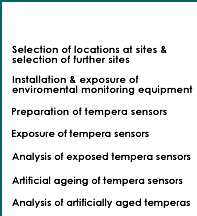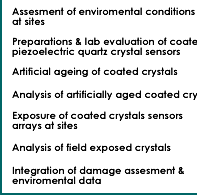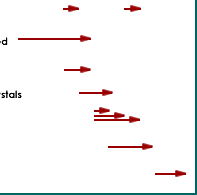



Description of Tasks
The project will involve preparation, exposure and subsequent evaluation of
damage dosimeters. Exposure will occur at a number of sites of varying conditions
of air quality, where air composition has been evaluated or will be as part
of this project. Specific locations within sites will be selected in close collaboration
between scientific and curatorial staff. Sites within four European countries
have already been selected, and these include both Northern and Southern European
countries and some locations which had been tested in previous projects but
where environmental conditions had not been fully evaluated. They represent
both urban and semi-rural conditions and provide examples of both highly and
less highly visited places. Monitoring of microclimate conditions will be performed
in the vicinity of selected paintings and particularly where recent problems
have been reported by curators and conservators. The effects of damage during
transportation of artworks, will also be investigated, where necessary.
Damage assessment will rely on the extensive in house database of physicochemical
changes in paint tempera dosimeters which have been quantified with respect
to artificial light and natural ageing. This database will be extended to provide
information on their response to various levels of pollutant gases. Work will
also include coating piezoelectric quartz crystals (PQCs) with paint tempera
and artists' materials, such as varnish. The change in the coating characteristics
will be read as a shift in the oscillation frequency of the crystal using a
frequency meter. The relation of frequency shift to damage will be calibrated
and coated piezoelectric crystals will be exposed to atmospheres of known light,
pollutant levels, relative humidity and temperature. Eventually the frequency
shift could be converted to a voltage to allow for continuous logging of damage
assessment data. The rationale for a European project is that environmental
quality and development of microclimates in collections is strongly affected
by local climates and so monitoring of sites in several countries will provide
a diversity of conditions ensuring a rich database for conservators.
The work packages are linked by one common aim, that of assessing the potential
of indoor environments to increase levels of damage to objects, and possibly
to alter the path of previous mechanisms of natural ageing. To achieve this
aim novel damage dosimeters will be prepared and exposed at a range of sites
in conjunction with a detailed environmental monitoring programme which includes
measurement of humidity, temperature, light and pollutant levels (NO2, SO2,
O3 and HONO).
The work plan is divided into five work packages which cover the scientific
development and preventive conservation aspects of the project.
The selection of sites and installation of monitoring equipment is detailed
in work packages 1 and 2. These refer to locations in Southern and Northern
Europe respectively. Work package 3 focuses on the preparation and supply of
paint based dosimeters on a polymer substrate to site exposure. It also includes
preparation and laboratory evaluation of novel coated piezoelectric quartz crystal
(PQCs). This is necessary to evaluate the suitability of the various proposed
coating materials, and in particular their long term performance. There is also
the need to evaluate the chemical sensing ability of the coating and how this
produces a change in the oscillation frequency of the crystal in response to
artificial ageing regimes. This work represents the novel technological aspects
of this project and is covered in work package 4, together with the chemical
analysis procedures. Methodologies for such analysis have been developed in
a previous project. The combination of colour measurements together with mass
spectrometric, thermoanalytical and spectroscopic techniques have yielded valuable
markers of the physicochemical state of coatings.
Work package 5 links together environmental monitoring data obtained at the
sites with the chemical assessment of damage of the coating (in terms of measurable
chemical markers) and resulting frequency shift parameters from the PQC coated
dosimeters. The use of pattern recognition techniques in conjunction with arrays
of sensors will enhance the extraction of useful data and minimise background
interference effects. It will also provide in future a method for assessing
cumulative damage in terms of a direct readout which can be made in house, rather
than requiring sophisticated chemical analysis.
Timing of Tasks
| Deliverable No | Deliverable title | Delivery date | ||
| WP1 | ||||
| 1 | Visual inspection of sites (El Alcázar, & selected sites in Spain and Italy) and assessment of existing damage to artworks, creation of database | 3 | ||
| 2 | Installation of commercial devices | 3 | ||
| 3 | Installation of novel damage dosimeters | 9 | ||
| 4 | Installation of passive samplers | 3-27 | ||
|
5 |
Reports suggesting improved preventive conservation strategies | 30 | ||
| 6 | Interaction with conservation training to promote preventive conservation practice | 24 | ||
| 7 | Establishment of website for the project | 18 | ||
| 8 | Arrangement of conferences in first two years for dissemination of knowledge | 18 | ||
| WP2 | ||||
| 9 | Visual inspection of sites (NT & NMD sites) and assessment of existing damage to artworks | 6 | ||
| 10 | Installation of monitoring equipment (RH, T, light, pollutants) | 6 | ||
| 11 | Passive samplers at each location | 6-27 | ||
| 12 | Installation of novel damage assessment dosimeters at each site | 9 | ||
| 13 | Reports on each site, detailing environmental hazards and results of monitoring programmes | 30 | ||
| WP3 | ||||
| 14 | Preparation of paint based dosimeters on polymer substrate, distribution for installation, and for artificial ageing involving pollutants (WP4) | 9 | ||
| 15 | Characterisation of paint based dosimeters (control samples) | 12 | ||
| 16 | Preparation of PQC dosimeters | 12 | ||
| 17 | Workshop on PQC technology/review article in Conservation journals | 30 | ||
| 18 | Characterisation of PQC dosimeters (mass spec) | 12 | ||
| 19 | Artificial light ageing of PQC dosimeters & analysis (mass spectrometry) | 18 | ||
| 20 | Simple prototype PQC dosimeter for use in galleries | 18 | ||
| 21 | Development of PQC based sensor for H2S | 30 | ||
| WP4 | ||||
| 22 | Database of pollutant levels at sites | 30 | ||
| 23 | Database of physicochemical changes caused by exposure of dosimeters to known pollutant levels | 30 | ||
| 24 | Measurement of naturally aged temperas | 30 | ||
| 25 | Correlation of frequency shift with chemical change in coatings of PQC based dosimeters | 30 | ||
| WP5 | ||||
| 26 | Natural ageing of paint dosimeters compared with artificial ageing of dosimeters (pollutants) & light | 36 | ||
| 27 | Assessment of damage at the sites | 36 | ||
| 28 | Calibrated coated sensor array | 36 | ||
| 29 | Improvement of environmental conditions at sites | 36 | ||
| 30 | Preparation of final report | 36 | ||
Project Workplan
    |